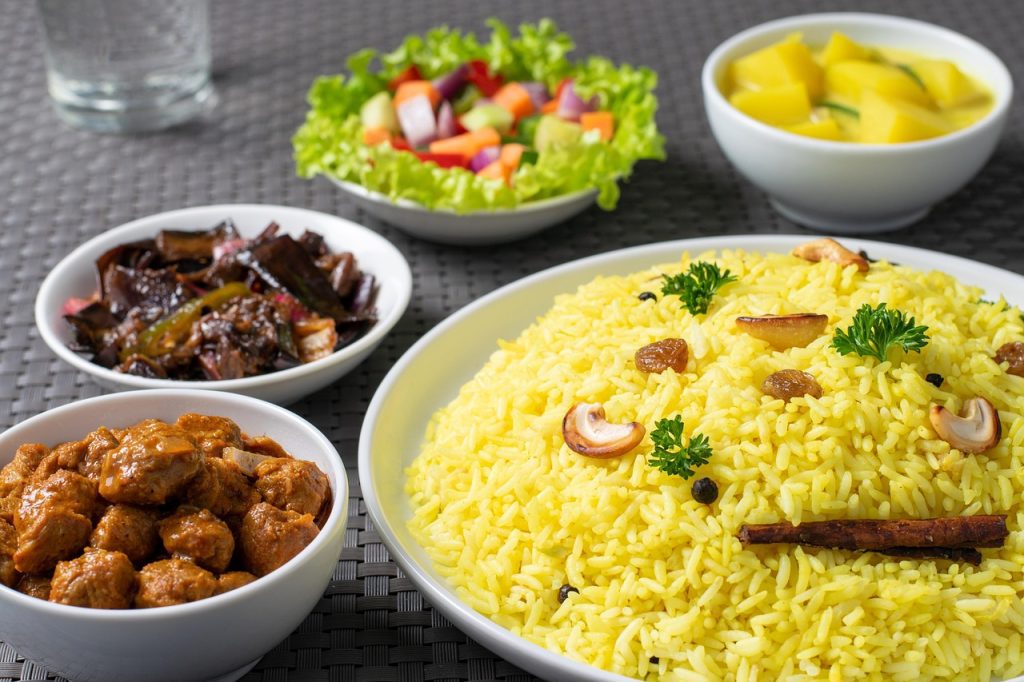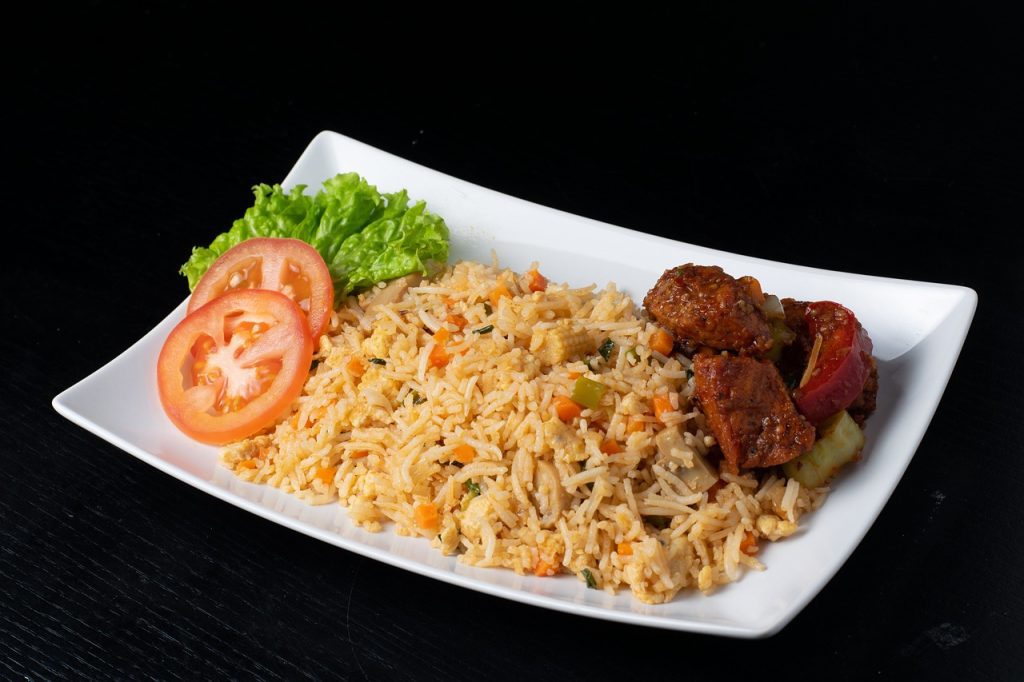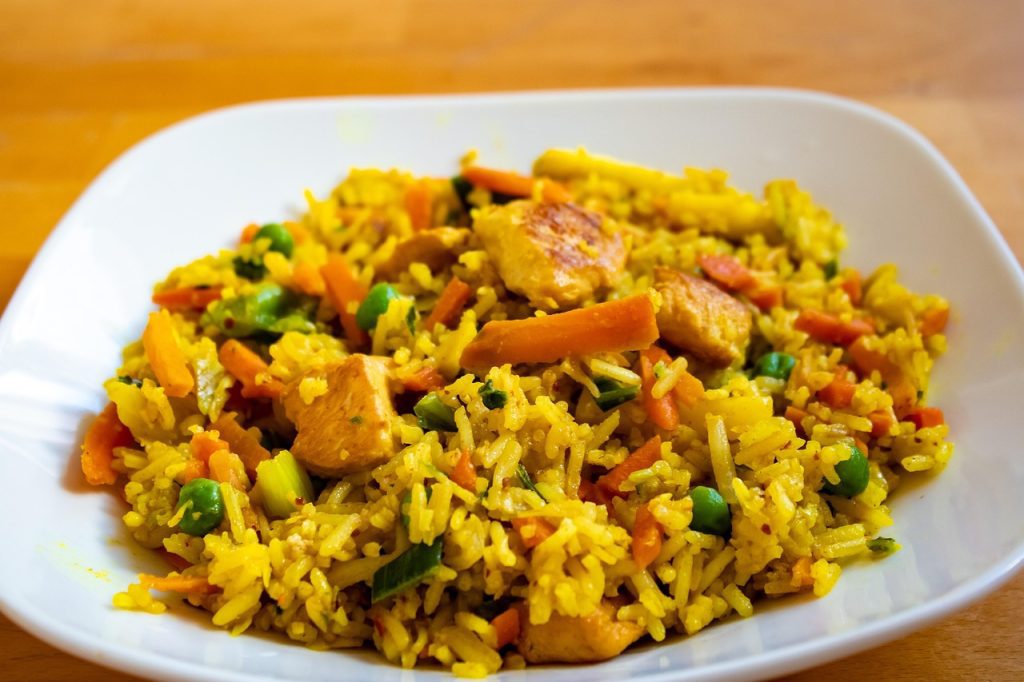Learn about What Rice Is Good With Curry. Discover the best rice for curry dishes. Explore perfect pairings like basmati, jasmine, jeera, brown, sticky, turmeric, and coconut rice for rich flavors.
Well-cooked rice garnished with a gravy of just the right saltiness, with slowly cooked meat or vegetables, or lentils, seasoned with spices, herbs, and sauces: This is the description of rice and curry. This is one of a few naturally occurring foods that have established themselves as cosmopolitan food in South Asia, Southeast Asia, and even the Caribbean. Every combination presents itself with its texture and its taste to comfort every bite, making it all the more pleasurable.
Understanding Rice and Curry
Rice and curry are boiled or steamed white rice served with many accompaniments, most of them curries. With different combinations of legumes and vegetables, use meat, seafood, or perhaps even eggs, just in ways determined by local traditions, available ingredients, and individual preferences.
Combinations are different depending on the region. In Sri Lanka, rice and curry are an everyday affair, trying to maintain some sort of balance between the hot, sour, and savory.

Meat curry, vegetable curries, lentil curry, most often referred to as dhal, fried condiments, pickles, and coconut sambol constitute a normal rice meal, while in Southern India, rice is accompanied by sambar, rasam, and various vegetable and/or meat curries.
What Rice Is Good With Curry?
1. Basmati Rice
Basmati rice is the fluffiest, the most aromatic, and milkiest rice that goes well with any Indian curry-be it butter chicken or tikka masala. The long grains absorb the flavors from the sauces without turning mushy, thereby enhancing the taste of rich and creamy curries with a mild, fragrant aroma.
Best Curries for Basmati Rice:
- Butter Chicken
- Chicken Tikka Masala
- Lamb Rogan Josh
- Palak Paneer
- Korma Curries
2. Jasmine Rice
Soft and somewhat sticky, jasmine rice has a perfumery flavor. It goes well with Thai curries-in particular green, red, or massaman-since it absorbs well coconut milk sauces. Lighter texture, being able to take on full-bodied spicy flavors, enhances the overall experience of the curry.
Best Curries for Jasmine Rice:
- Thai Green Curry
- Thai Red Curry
- Massaman Curry
- Malaysian Laksa Curry
- Indonesian Rendang
3. Jeera (Cumin) Rice
Jeera rice flavored with cumin seeds and made with ghee has an excellent nutty aroma and is perfectly suitable for spicier Indian curries. For example, it goes extraordinarily well with dal tadka or lamb curry because the very mild flavor of cumin complements the taste of your curry without being overpowering.
Best Curries for Jeera Rice:
- Paneer Butter Masala
- Shahi Paneer
- Mutton Korma
- Kofta Curry
4. Brown Rice
Brown rice is healthy and has a rich fiber content and a somewhat nutty taste. It merges well with vegetable or lentil-based curries, adding a wholesome texture. Built-up grains withstand hearty, thick sauces and present a balmy and healthy alternative to white rice.
Best Curries for Brown Rice:
- Chickpea Curry (Chana Masala)
- Lentil Dal
- Vegetable Korma
- Spinach and Potato Curry (Saag Aloo
- Eggplant Curry
5. Sticky Rice (Glutinous Rice)
Sticky rice goes best between your mouth and Thai or Laotian curries. It possesses the right chewy consistency for the exceptional experience of scooping up rich, thick sauces. Its slightly sweet taste goes well with curries that are either piquant or savory, giving it a different experience when eating with dry or coconut-based curry dishes.
Best Curries for Sticky Rice:
- Laotian Or Lam Curry
- Thai Nam Prik (Chili Paste) with Pork Curry
- Northern Thai Dry Beef Curry
- Fermented Fish Curries
6. Turmeric Rice
Turmeric rice adds that bright yellow color and gentle spice to your plate. Coats perfectly Indian and Middle Eastern curries, brings out the flavor of the aromatic spices. And the mild earthiness turmeric brings only serves to accentuate flavor and color to the plate.
7. Coconut Rice
Coconut rice is milky, slightly sweet, and a great pairing with Thai or Caribbean-style curries. The richness of coconut mellows the spicy, tangy sauces, ending things on a most mellow note. Especially when served with seafood or chicken curry, every bite has a tropical zing.
Best Curries for Coconut Rice:
- Sri Lankan Fish Curry
- Goan Prawn Curry
- Caribbean Chicken Curry
- Thai Yellow Curry
Why Basmati Rice is the Best for Curry
In the opinion of curry lovers, basmati rice, among all the rice varieties, is the ultimate variety. Light and fluffy with a gentle fragrance, it enhances the bold and rich taste of curry; it is quite versatile and easy to prepare.
Tips for Choosing the Best Rice for Curry
- Consider the Curry Texture: For rich and creamy curries, choose fluffy basmati rice or jasmine, while proper absorption of flavors without making the rice mushy would match with medium-grain or parboiled rice for soupy or runny curries.
- Balance the Flavors: Simple, bland rice takes away the more potent spicy overtones from a curry and balances the overall flavors. Jeera rice or coconut rice becomes yet more flavoring rice to a simple curry and adds that extra aroma to the meal.
- Nutritional Preferences: If you aim for a healthy rice choice sprinkled with fiber and nutrients, brown or wild rice will suit your purpose. These rice types impart their earthy flavor and chewy texture, thus making your curry meals delightful and healthy.
- Regional Match: Go for rice types used traditionally in the curry’s place of origin: Thai curries will fit beautifully with jasmine rice, Indian with basmati, while sticky rice completes the taste experience of Laos and Northern Thai curry.
Nutritional Value of Rice and Curry
Traditionally prepared, rice and curry provide a nutritious meal. Rice carbohydrates combined with proteins from meat or lentils, and fibers and vitamins coming from vegetables make it wholesome. The spices in use also bring several health benefits: anti-inflammatory and digestive properties.
On the contrary, the calorie count also depends on how much oil and coconut milk are used. The option of red rice or brown rice makes it healthier in more ways than one by containing more fiber and lowering the glycemic index making it healthier.

FAQs
Is Jeera rice good with curry?
The curry scent mingling with the aroma of jeera rice does the trick. The beautiful smell of the cumin seeds, frying away and flavoring the rice, adds another dimension to the very many spices that have been added to the curry and is the perfect compliment to the entire flavor profile of the dish.
Does red rice taste good with curry?
Red rice is among the top choices regarding food options, given that it is a valued variety in Sri Lankan cuisine. It offers an earthy flavor and firm texture which provides a bit of balance to very spicy curries, not to mention the added antioxidant and fiber nutritional benefits.
Is brown rice a good option for curry?
Brown rice would be a healthy option that blends quite well with curry. It imparts a nutty flavor and chewy texture while providing greater fiber and nutrients and counterbalancing the taste of rich meat or vegetable curries.
Conclusion
Choosing the right rice is as essential as the curry itself. Basmati is the all-time champion rice for Indian curries, while jasmine complements Thai flavors best. Brown and wild rice make healthy meals; coconut, lemon, or jeera rice tastes like gold. Ultimately, the right rice completes the curry-enhanced experience, every mouthful a flavorful journey.
